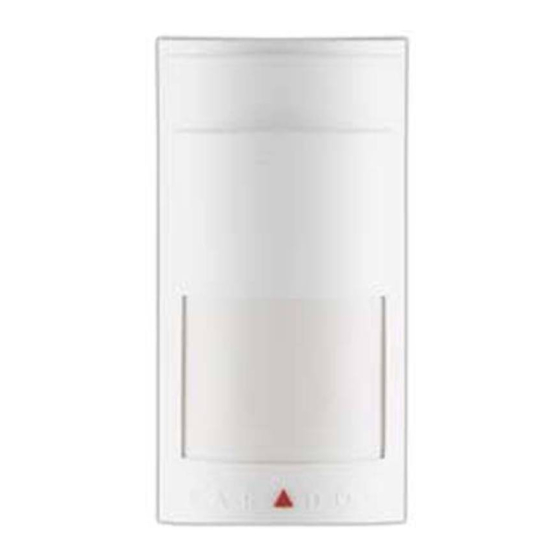
Paradox Magellan PMD1P - Analog Single-Optic PIR Manual
- Instructions (2 pages)
Advertisement

Installation
At the installation height of 2.1m (7ft)±10%, PMD1P (previously MG-PMD1P) provides full coverage from 1.2m (4ft) to 11m (35ft).
Avoid placing the motion detector in proximity to potential sources of interference such as: reflective surfaces, direct air flow from vents, fans, windows, sources of steam/oil vapor, and objects causing temperature changes such as heaters, refrigerators, ovens, and infrared light sources. Do not place objects or furniture higher than 0.9m (3ft), which a pet can climb onto (e.g. a cat on a couch), within 2.1m (7ft) of the detector. In addition, do not aim the detector at a stairway to which a pet may have access.

Compatibility
| Magellan Mode | MG5000/MG5050 |
| SP5500/SP6000/SP7000 with RTX3 | |
| EVO48/EVO192 with RTX3 | |
| MG6160/MG6130, MG6060/MG6030 | |
| RTX3/RCV3 | |
| 1759MG | |
| Omnia Mode | OMN-RCV3 |
| 1759EX |
Pet Immunity
An animal's immunity to false alarms depends on its size, temperature, and length of coat. Longer hair and smaller size make an animal more likely to be immune, while shorter hair and larger animals are more likely to create a false alarm. When a higher level of immunity is required, such as when animals are constantly in the detection area, consider using our PMD75 digital dual-sensor highperformance PIR (40kg/90lbs true pet immunity).
The PMD1P pet immunity feature has not yet been investigated by UL.
Jumper Settings
| J1 | Check-in Supervision Time | |
| OFF = | 12 minutes | |
| ON = | 12 hours  | |
Jumper J1 sets the time interval in which the detector communicates a check-in signal when used with Omnia or Spectra 1759EX (see J2 description). If the detector is used with a Magellan receiver (see J2 description), J1 is disabled and the detector will regularly transmit a check-in signal to Magellan. The check-in supervision time is set in the Magellan receiver. With an OMN-RCV3 V2.0 or higher, the receiver automatically detects the check-in time set in each of its assigned transmitters. As a result, the transmitters can have different check-in times. With a previous version of the OMN-RCV3, the transmitter check-in time needs to match the setting in the module.
| J2 | Operating Mode | |
| OFF = | Omnia/1759EX | |
| ON = | Magellan/1759MG  | |
PMD1P can function on either the Magellan or Omnia communication protocol. Set J2 according to which receiver the PMD1P will communicate with.
| J3 | Sensitivity Setting | |
| OFF = | High Sensitivity  | |
| ON = | Low Sensitivity | |
High Sensitivity should be used in normal environments with minimal sources of interference. Low Sensitivity provides better false alarm rejection if the detector is placed near sources of interference where the incidence of false alarms may be greater.
| J4 | Fast / Slow Mode | |
| OFF = | Slow Mode | |
| ON = | Fast Mode  | |
Slow Mode: Recommended for areas where the incidence of false alarms may be greater. The ammount of movement required to generate an alarm is doubled.
Fast Mode: Recommended for the majority of installations.
| J5 | LED Feedback | |
| OFF = | LED deactivated | |
| ON = | LED activated  | |
LED Feedback
The red LED will illuminate for a period of 2 seconds if any movement is detected. The red LED indicator light will blink rapidly when the motion detector transmits a signal to the receiver.
 =default
=default

Powering the Device
To power the detector, follow the instructions supplied on the detector's cover. After inserting the batteries, a power-up sequence begins (lasting 10-30 seconds). During this time, the red LED flashes and the detector will not detect an open zone or tamper.
Low Battery
The PMD1P performs a battery test every 12 hours. If battery voltage drops below a certain level, the red LED flashes at 5-second intervals and the motion detector will send a low battery signal to the receiver. A trouble is generated and then transmitted to the central monitoring station.
Alive Software
To conserve the motion detector's battery life, if the motion detector transmits 2 open zone signals (LED on for 2s) within a 5-minute period, the detector will fall into Energy Save Mode for approximately 3 minutes and will not transmit any alarm signals. The red LED will continue to flash to indicate a detection. If the detector's cover is removed and then replaced while in Energy Save Mode, the first detection will trigger an alarm signal.
Walk-testing
To activate Walk-test Mode for three minutes, power up the detector or open and close the detector's cover. In fast mode (J4 = ON), at 20°C, crossing more than one complete zone (consisting of two beams left and right sensor detecting elements) with slow/fast walking or running should initiate an alarm. In slow mode (J4 = OFF), the amount of movement required to generate an alarm is doubled.
Signal Strength Test
In order to verify proper signal reception, perform a signal strength test as described in the receiver's Reference and Installation Manual. Prior to performing the test, ensure the batteries have been installed. Also verify that the motion detector has been assigned to a zone according to the instructions in the receiver's Reference and Installation Manual. If the transmission is weak, relocating the transmitter by a few inches can greatly improve the reception.

Documents / Resources
References
Download manual
Here you can download full pdf version of manual, it may contain additional safety instructions, warranty information, FCC rules, etc.
Download Paradox Magellan PMD1P - Analog Single-Optic PIR Manual
Advertisement




















Need help?
Do you have a question about the Magellan PMD1P and is the answer not in the manual?
Questions and answers